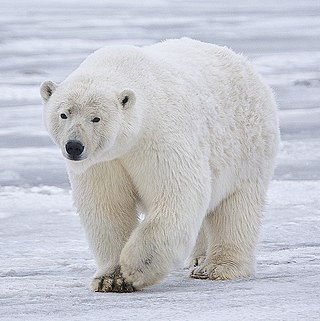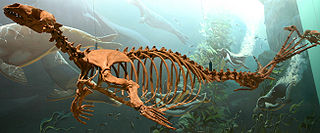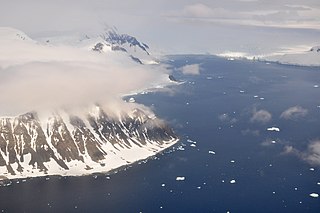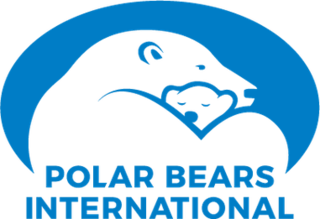Related Research Articles

The polar bear is a large bear native to the Arctic and nearby areas. It is closely related to the brown bear, and the two species can interbreed. The polar bear is the largest extant species of bear and land carnivore, with adult males weighing 300–800 kg (660–1,760 lb). The species is sexually dimorphic, as adult females are much smaller. The polar bear is white- or yellowish-furred with black skin and a thick layer of fat. It is more slender than the brown bear, with a narrower skull, longer neck and lower shoulder hump. Its teeth are sharper and more adapted to cutting meat. The paws are large and allow the bear to walk on ice and paddle in the water.

The Arctic is a polar region located at the northernmost part of Earth. The Arctic consists of the Arctic Ocean, adjacent seas, and parts of Canada, Danish Realm (Greenland), northern Finland, Iceland, northern Norway, Russia, northernmost Sweden and the United States (Alaska). Land within the Arctic region has seasonally varying snow and ice cover, with predominantly treeless permafrost under the tundra. Arctic seas contain seasonal sea ice in many places.

The ringed seal is an earless seal inhabiting the Arctic and sub-Arctic regions. The ringed seal is a relatively small seal, rarely greater than 1.5 m in length, with a distinctive patterning of dark spots surrounded by light gray rings, hence its common name. It is the most abundant and wide-ranging ice seal in the Northern Hemisphere, ranging throughout the Arctic Ocean, into the Bering Sea and Okhotsk Sea as far south as the northern coast of Japan in the Pacific and throughout the North Atlantic coasts of Greenland and Scandinavia as far south as Newfoundland, and including two freshwater subspecies in northern Europe. Ringed seals are one of the primary prey of polar bears and killer whales, and have long been a component of the diet of indigenous people of the Arctic.

The Weddell seal is a relatively large and abundant true seal with a circumpolar distribution surrounding Antarctica. The Weddell seal was discovered and named in the 1820s during expeditions led by British sealing captain James Weddell to the area of the Southern Ocean now known as the Weddell Sea. The life history of this species is well documented since it occupies fast ice environments close to the Antarctic continent and often adjacent to Antarctic bases. It is the only species in the genus Leptonychotes.
Polar ecology is the relationship between plants and animals in a polar environment. Polar environments are in the Arctic and Antarctic regions. Arctic regions are in the Northern Hemisphere, and it contains land and the islands that surrounds it. Antarctica is in the Southern Hemisphere and it also contains the land mass, surrounding islands and the ocean. Polar regions also contain the subantarctic and subarctic zone which separate the polar regions from the temperate regions. Antarctica and the Arctic lie in the polar circles. The polar circles are imaginary lines shown on maps to be the areas that receives less sunlight due to less radiation. These areas either receive sunlight or shade 24 hours a day because of the earth's tilt. Plants and animals in the polar regions are able to withstand living in harsh weather conditions but are facing environmental threats that limit their survival.

A grizzly–polar bear hybrid is a rare ursid hybrid that has occurred both in captivity and in the wild. In 2006, the occurrence of this hybrid in nature was confirmed by testing the DNA of a unique-looking bear that had been shot near Sachs Harbour, Northwest Territories, on Banks Island in the Canadian Arctic. The number of confirmed hybrids has since risen to eight, all of them descending from the same female polar bear.

Acrophoca longirostris, sometimes called the swan-necked seal, is an extinct genus of Late Miocene pinniped. It was thought to have been the ancestor of the modern leopard seal; however, it is now thought to be a species of monk seal.

Arctic ecology is the scientific study of the relationships between biotic and abiotic factors in the arctic, the region north of the Arctic Circle. This region is characterized by two biomes: taiga and tundra. While the taiga has a more moderate climate and permits a diversity of both non-vascular and vascular plants, the tundra has a limited growing season and stressful growing conditions due to intense cold, low precipitation, and a lack of sunlight throughout the winter. Sensitive ecosystems exist throughout the Arctic region, which are being impacted dramatically by global warming.

Polar Bear Pass National Wildlife Area is a National Wildlife Area on Bathurst Island within Qikiqtaaluk, Nunavut, Canada. It is on federal Crown land, and is administered by the Canadian Wildlife Service, a division of Environment Canada, with respect to the Canada Wildlife Act's National Wildlife Area Regulations. Land use is also subject to the Nunavut Land Claims Agreement. To the north and west is Qausuittuq National Park.

Hauling-out is a behaviour associated with pinnipeds temporarily leaving the water. Hauling-out typically occurs between periods of foraging activity. Rather than remain in the water, pinnipeds haul-out onto land or sea-ice for reasons such as reproduction and rest. Hauling-out is necessary in seals for mating and giving birth. Other benefits of hauling-out may include predator avoidance, thermoregulation, social activity, parasite reduction and rest.
Spencer Island is one of several uninhabited Canadian arctic islands in Nunavut, Canada located within James Bay. It is situated 19 km (19,000 m) northwest from North Twin Island. During surveys in James Bay, polar bears were sighted using the island for summer refuge.

Pagophily or pagophilia is the preference or dependence on water ice for some or all activities and functions. The term Pagophila is derived from the Ancient Greek pagos meaning "sea-ice", and philos meaning "-loving".
Mitchell Taylor is a Canadian biologist specializing in polar bears who claims that Canada's polar bear population is higher now than it was 30 years ago and that polar bears are not currently threatened by climate change. He is currently a contract adjunct professor at Lakehead University, and he is affiliated with the Heartland Institute.

Bernard Stonehouse was a British scientist who specialised in animal behaviour, polar research and popular science. In 1953 he received the Polar Medal.

Polar Bears International (PBI) is a non-profit polar bear conservation organization. Their research, education, and action programs address the issues that are endangering polar bears. The organization also studies polar bears and monitors their activity data which helped lead to the animals being listed as a threatened species. While Churchill, Canada, serves as an important hub for PBI scientists and educators, the organization's work on behalf of polar bears spans the Arctic including Svalbard, Russia, and Alaska.

The North Water Polynya (NOW), or Pikialasorsuaq to Inuit in Greenland and Sarvarjuaq to Inuit in Canada, is a polynya that lies between Greenland and Canada in northern Baffin Bay. The world's largest Arctic polynya at about 85,000 km2 (33,000 sq mi), it creates a warm microclimate that provides a refuge for narwhal, beluga, walrus, and bowhead whales to feed and rest. While thin ice forms in some areas, the polynya is kept open by wind, tides and an ice bridge on its northern edge. Named the "North Water" by 19th century whalers who relied on it for spring passage, this polynya is one of the most biologically productive marine areas in the Arctic Ocean.

Julian A. Dowdeswell ScD FLSW is a British glaciologist and a Professor of Physical Geography in the Department of Geography at the University of Cambridge, and from 2002 to 2021 was the Director of the Scott Polar Research Institute.
Kit Kovacs is a marine mammal researcher, best known for her work on biology, conservation and management of whales and seals. She is based at the Norwegian Polar Institute (NPI), Tromsø and is an Adjunct professor of biology, Marine Biology, at the University Centre in Svalbard (UNIS).
Susan Janet Crockford is a Canadian contract scientist who runs a small business identifying bones and other items in scat of wildlife. She is a blogger who writes about zoology and climate science, specializing in Holocene mammals. From 2004 to 2019 she was an adjunct professor in Anthropology at the University of Victoria. She is known for her blog posts on polar bear biology, which are unsupported by the scientific literature and oppose the scientific consensus that polar bears are threatened by ongoing climate change.

Polar bear population sizes and trends are difficult to estimate accurately because they occupy remote home ranges and exist at low population densities. Polar bear fieldwork can also be hazardous to researchers. As of 2015, the International Union for Conservation of Nature (IUCN) reports that the global population of polar bears is 22,000 to 31,000, and the current population trend is unknown. Nevertheless, polar bears are listed as "Vulnerable" under criterion A3c, which indicates an expected population decrease of ≥30% over the next three generations due to "decline in area of occupancy, extent of occurrence and/or quality of habitat". Risks to the polar bear include climate change, pollution in the form of toxic contaminants, conflicts with shipping, oil and gas exploration and development, and human-bear interactions including harvesting and possible stresses from recreational polar-bear watching.
References
- ↑ "The Council of Science Editors (CSE) - 2007 Annual Meeting". Councilscienceeditors.org. Archived from the original on April 3, 2008.
{{cite web}}: CS1 maint: unfit URL (link) - ↑ "CBC News Indepth: Polar Bears". Cbc.ca. 6 July 2004. Archived from the original on October 12, 2007.
{{cite web}}: CS1 maint: unfit URL (link) - ↑ Grote, Stirling, Ian (1 January 1965). Studies of the holding, behaviour and nutrition of captive blue grouse (Thesis). University of British Columbia. doi:10.14288/1.0302522. hdl:2429/37452.
{{cite thesis}}: CS1 maint: multiple names: authors list (link) - ↑ Stirling, Ian (1968). "Population ecology of the Weddell seal (Leptonychotes weddelli) in McMurdo Sound, Antarctica". doi:10.26021/6015. hdl:10092/6646.
{{cite journal}}: Cite journal requires|journal=(help) - ↑ Stirling, Ian (1968). Population ecology of the Weddell seal (Leptonychotes weddelli) in McMurdo Sound, Antarctica (Doctoral thesis). UC Research Repository, University of Canterbury. doi:10.26021/6015. hdl:10092/6646.
- ↑ Stirling, Ian; Derocher, Andrew E. (1993). "Possible impacts of climatic warming on polar bears". Arctic. Arctic Institute of North America. 46 (3): 240–245. doi: 10.14430/arctic1348 .
- ↑ "TheStar.com - Arctic In Peril - Polar bear population on thin ice". Thestar.com. 26 November 2007. Archived from the original on April 3, 2008.
{{cite web}}: CS1 maint: unfit URL (link) - ↑ "Dr. Ian Stirling, O.C. - Graduation at UBC". Graduation.ubc.ca. Retrieved 2016-07-08.
- ↑ "Society for Marine Mammalogy". Marinemammalscience.org. Retrieved 2016-07-08.
- ↑ "Weston Family Prize for Lifetime Achievement in Northern Research - ACUNS/AUCEN: Association of Canadian Universities for Northern Studies / Association universitaire canadienne d'études nordiques". Acuns.ca. Retrieved 2016-07-08.